The Circle, the Square, and The Vitruvian Man

The Circle and the Square
Leonardo da Vinci created the Vitruvian Man over 500 years ago in the late 15th century of Renaissance Florence. While the Man in the drawing appears to be the focal point, it’s his relationship to the circle and the square in which he is drawn that gives the piece context and meaning.
The Renaissance Period of history is characterized by the revival of classical learning and the development in humanism and innovation across multiple disciplines. And so, the Vitruvian Man is among the works of art that beautifully illustrate that blending of art, science, and philosophy.
The circle is a geometric shape whose circumference is drawn with equidistant points on a radius originating from its center – in this drawing it's the man's belly button. But the circle is also symbolic of the divine perfection found in the natural world, reflecting an eternal and harmonious flow.
The square is another geometric shape with four sides of equal length connected at four right angles. In this drawing, the width of his arm span is equal to his height. This underscores the mathematical and intellectual framework reflected in human anatomy and further represents stability and rationality.
Together, these geometric shapes epitomize the Renaissance synthesis of art and science, overlapping da Vinci's exploration of the interconnectedness of the microcosm (human body) and macrocosm (larger universe).
On the back wall at Vitruvian Fitness, we painted our version of the Vitruvian Man as recognition of the interconnected relationships within our body and interdependent relationships of our bodies with the world around us. Not only are our various bodily systems (musculoskeletal, cardiovascular, nervous, endocrine . . . .) inseparable in our approach to health and fitness, neither are our bodies separable from our minds and our environment.
Art, science, philosophy, movement, community, humanism – it’s all one.
Read more about the Vitruvian Man: nicofranz.art, wikipedia.org, stanford.edu.
Curious to learn more about Vitruvian Fitness?
We encourage you to do a 14-Day Trial Membership. In 14 days, you will get a private onboarding session that includes the Functional Movement Screen®, then unlimited semi-private training sessions doing the program we design based on that first session. And you’ll get to be a part of one of the most inviting, inclusive, and fun communities you’ll find anywhere. At the end of your trial, you get to decide if you liked it and if you want to continue with a regular 6-month membership. All the options and prices are on our Membership page.
Click here to sign up now or click the Get Started button to schedule a call to learn more.
You might also enjoy these posts . . .







